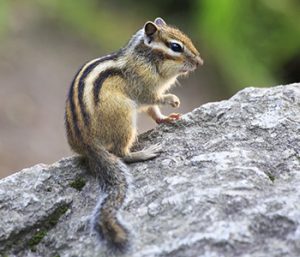Eastern Chipmunks
Biology
The eastern chipmunk is found in the eastern part of North America. The eastern chipmunk is a common rodent. It is a forest animal, but it has become comfortable living near people. This chipmunk lives a solitary life, except during mating season. Females normally give birth to 1-2 litters consisting of 3-5 young.
The chipmunk is a small, ground living member of the squirrel family. It has two tan and five blackish long stripes on its back, and two tan and two brownish stripes on each side of its face. The long stripes end at the reddish rump. The tail is 3 to 4 inches long. Adults may live up to 8 years but are prey for hawks, owls, foxes, raccoons, coyotes, snakes, and domestic cats and dogs. Thus in the wild, chipmunks normally live up to 3 years.
Feeding Preferences
The chipmunk feeds on fruits, grains, nuts, berries, seeds, mushrooms, insects, worms, and bird eggs.
Transmitted Diseases
Chipmunks are a member of the rodent family and rodents of all types are known for transmitting of diseases. The Plague is transmitted by wild rodents, including squirrels, prairie dogs, wood rats, fox squirrels and chipmunks. The Disease is spread through the bite of an infected flea, or with direct contact with an infected animal.
Habits
When chipmunks eat, they sit upright and hold food with their front feet. The Eastern chipmunk naturally lives in woodlands and woodlot edges, but they are also found in and around homes. The range of a chipmunk home may be up to 1/2 acre, but the adult only defends an area of 50 feet around its lair entrance. They dig out the soil, so tunnel entrances are well hidden. Chipmunks are most active during the early morning and late afternoon. .
With the onset of cold winter, chipmunks enter a uneasy hibernation and are idle from late fall through the winter. They do not enter a deep hibernation, but rely on the supply of food they have brought to their burrow. Most chipmunks emerge from their hibernation in early spring. Chipmunks are a valuable forest resident by spreading seeds via fecal droppings, this helps with tree regeneration.
Structural Pest Chipmunk Program
Our service technician will perform a thorough inspection on the exterior and interior of your structure to locate all problem areas and properly identify the pest you are having.
All programs are specially designed to target the pest that is infesting your structure.

